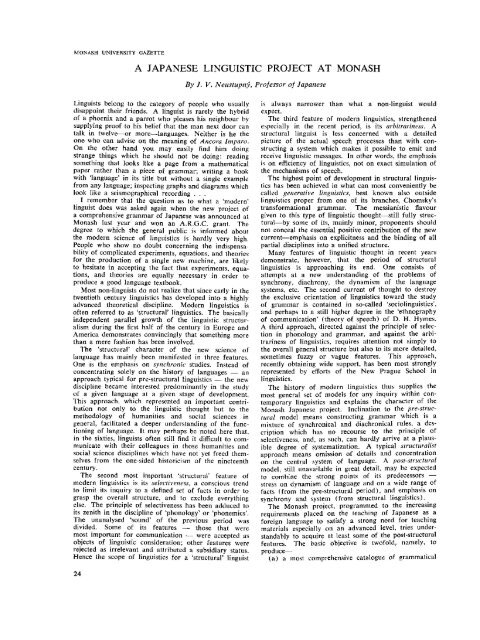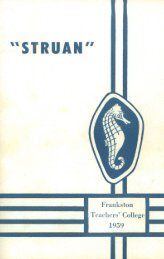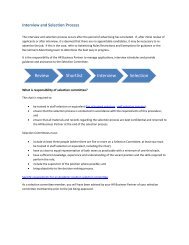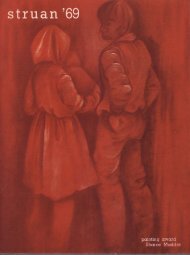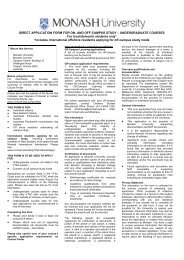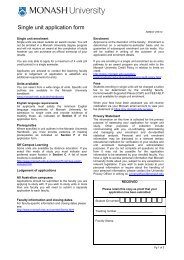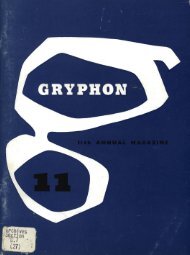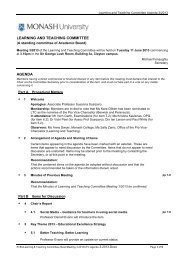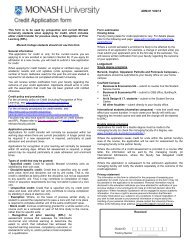Volume 6 Number 1 - Adm.monash.edu - Monash University
Volume 6 Number 1 - Adm.monash.edu - Monash University
Volume 6 Number 1 - Adm.monash.edu - Monash University
You also want an ePaper? Increase the reach of your titles
YUMPU automatically turns print PDFs into web optimized ePapers that Google loves.
MONASH UNIVERSITY GAZETTE<br />
A JAPANESE LINGUISTIC PROJECT AT MONASH<br />
By J. V. Neustupny, Professor of Japanese<br />
Linguists belong to the category of people who usually<br />
disappoint their friends. A linguist is rarely the hybrid<br />
of a phoenix and a parrot who pleases his neighbour by<br />
supplying proof to his belief that the man next door can<br />
talk in twelve-or more-languages. Neither is he the<br />
one who can advise on the meaning of Ancora lmparo.<br />
On the other hand you may easily find him doing<br />
strange things which he should not be doing: reading<br />
something that looks like a page from a mathematical<br />
paper rather than a piece of grammar; writing a book<br />
with 'language' in its title but without a single example<br />
from any language; inspecting graphs and diagrams which<br />
look like a seismographical recording .<br />
I remember that the question as to what a 'modern'<br />
linguist does was asked again when the new project of<br />
a comprehensive grammar of Japanese was announced at<br />
<strong>Monash</strong> last year and won an A.R.G.C. grant. The<br />
degree to which the general public is informed about<br />
the modern science of linguistics is hardly very high.<br />
People who show no doubt concerning the indispensability<br />
of complicated experiments, equations, and theories<br />
for the production of a single new machine, are likely<br />
to hesitate in accepting the fact that experiments, equations,<br />
and theories are equally necessary in order to<br />
produce a good language textbook,<br />
Most non-linguists do not realize that since early in the<br />
twentieth century linguistics has developed into a highly<br />
advanced theoretical discipline. Modern linguistics is<br />
often referred to as 'structural' linguistics. The basically<br />
independent parallel growth of the linguistic structuralism<br />
during the first half of the century in Europe and<br />
America demonstrates convincingly that something more<br />
than a mere fashion has been involved.<br />
The 'structural' character of the new science of<br />
language has mainly been manifested in three features.<br />
One is the emphasis on synchronic studies. Instead of<br />
concentrating solely on the history of languages - an<br />
approach typical for pre-structural linguistics - the new<br />
discipline became interested predominantly in the study<br />
of a given language at a given stage of development.<br />
This approach. which represented an important contribution<br />
not only to the linguistic thought but to the<br />
methodology of humanities and social sciences III<br />
general, facilitated a deeper understanding of the functioning<br />
of language. It may perhaps be noted here that.<br />
in the sixties, linguists often still find it difficult to communicate<br />
with their colleagues in those humanities and<br />
social science disciplines which have not yet freed themselves<br />
from the one-sided historicism of the nineteenth<br />
century,<br />
The second most important 'structural' feature of<br />
modern linguistics is its selectiveness, a conscious trend<br />
to limit its inquiry to a defined set of facts in order to<br />
grasp the overall structure, and to exclude everything<br />
else. The principle of selectiveness has been adduced to<br />
its zenith in the discipline of 'phonology' or 'phonemics',<br />
The unanalysed 'sound' of the previous period was<br />
divided. Some of its features - those that were<br />
most important for communication - were accepted as<br />
objects of linguistic consideration; other features were<br />
rejected as irrelevant and attributed a subsidiary status.<br />
Hence the scope of linguistics for a 'structural' linguist<br />
is always narrower than what a non-linguist would<br />
expect.<br />
The third feature of modern linguistics, strengthened<br />
especially in the recent period, is its arbitrariness. A<br />
structural linguist is less concerned with a detailed<br />
picture of the actual speech processes than with constructing<br />
a system which makes it possible to emit and<br />
receive linguistic messages. In other words, the emphasis<br />
is on efficiency of linguistics, not on exact simulation of<br />
the mechanisms of speech.<br />
The highest point of development in structural linguistics<br />
has been achieved in what can most conveniently be<br />
called generative linguistics, best known also outside<br />
linguistics proper from one of its branches, Chomsky's<br />
transformational grammar. The messianistic flavour<br />
given to this type of linguistic thought-still fully structural-by<br />
some of its, mainly minor, proponents should<br />
not conceal the essential positive contribution of the new<br />
current-emphasis on explicitness and the binding of all<br />
partial disciplines into a unified structure.<br />
Many features of linguistic thought in recent years<br />
demonstrate, however, that the period of structural<br />
linguistics is approaching its end. One consists of<br />
attempts at a new understanding of the problems of<br />
synchrony, diachrony, the dynamism of the language<br />
systems, etc. The second current of thought to destroy<br />
the exclusive orientation of linguistics toward the study<br />
of grammar is contained in so-called 'sociolinguistics',<br />
and perhaps to a still higher degree in the 'ethnography<br />
of communication' (theory of speech) of D. H. Hymes,<br />
A third approach, directed against the principle of selection<br />
in phonology and grammar, and against the arbitrariness<br />
of linguistics, requires attention not simply to<br />
the overall general structure but also to its more detailed,<br />
sometimes fuzzy or vague features. This approach,<br />
recently obtaining wide support, has been most strongly<br />
represented by efforts of the New Prague School in<br />
linguistics,<br />
The history of modern linguistics thus supplies the<br />
most general set of models for any inquiry within contemporary<br />
linguistics and explains the character of the<br />
<strong>Monash</strong> Japanese project. Inclination to the pre-structural<br />
model means constructing grammar which is a<br />
mixture of synchronical and diachronical rules, a description<br />
which has no recourse to the principle of<br />
selectiveness, and, as such, can hardly arrive at a plausible<br />
degree of systematization. A typical structuralist<br />
approach means omission of details and concentration<br />
on the central system of language. A post-structural<br />
model, still unavailable in great detail, may be expected<br />
to combine the strong points of its predecessors <br />
stress on dynamism of language and on a wide range of<br />
facts (from the pre-structural period). and emphasis on<br />
synchrony and system (from structural linguistics).<br />
The <strong>Monash</strong> project, programmed to the increasing<br />
requirements placed on the teaching of Japanese as a<br />
foreign language to satisfy a strong need for teaching<br />
materials especially on an advanced level. tries understandably<br />
to acquire at least some of the post-structural<br />
features. The basic objective is twofold, namely, to<br />
produce<br />
(a) a most comprehensive catalogue of grammatical<br />
24


